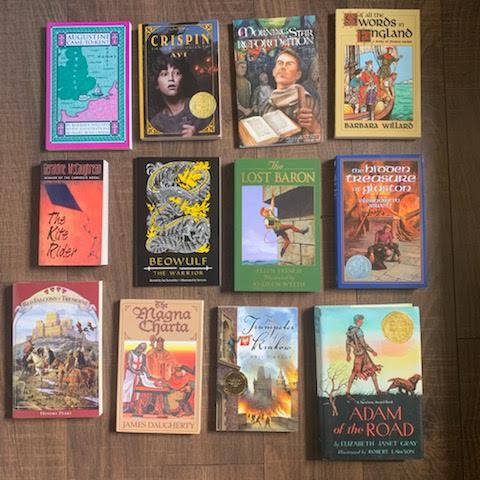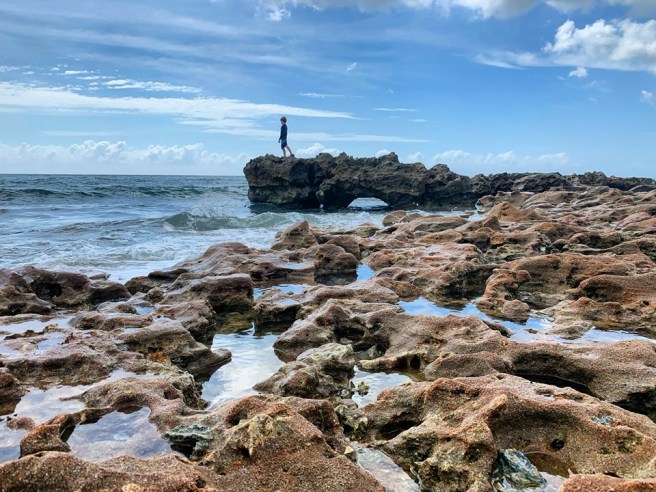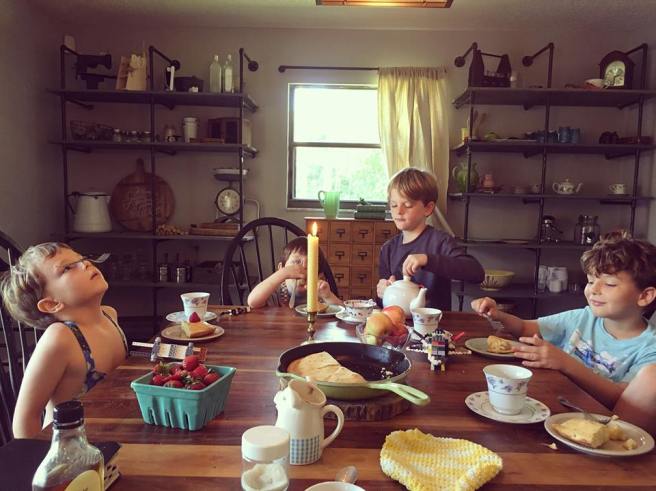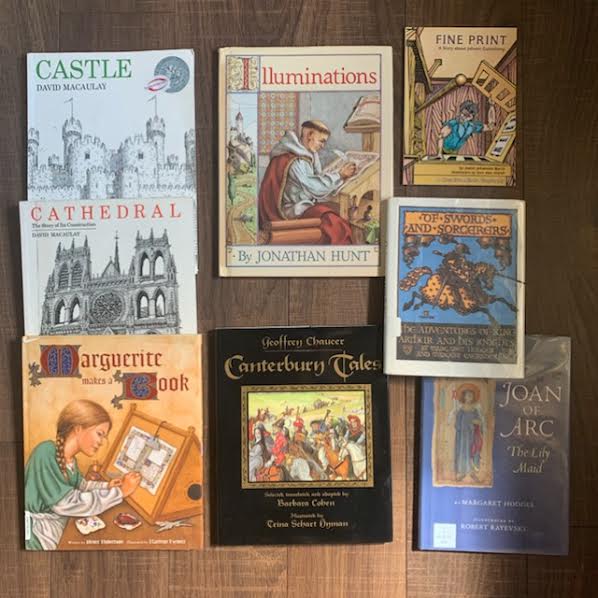Hello friends!
Thank you for your patience. I know many of you have been waiting quite a few weeks for this list to be posted. We’ve been busy since the end of CC with many travels and are now settled in for the summer months, happily diving into our study of European History. We are beginning with the Fall of Rome, leading into the Middle Ages for the beginning of Cycle 2 in the autumn.
Below you will find our plan for the first quarter with details about each portion of our schedule, including our Morning Time selections and explanations for each part of our routine. I share this not because I think an exact copy of our schedule would work for everyone, but to give you a few ideas that might work for your family and your schedule or simply provide a glimpse into someone else’s homeschool life and the freedom their choices has given them. Ultimately, you must find what serves your particular family’s needs best and since you are the world’s leading expert on your children, you are the master planner, not I! I urge you to walk in the freedom to glean from this post rather than consumption out of fear. 🙂

The book lists for weeks 1-6 and extra resource list will follow at the end of the post. Please note that my family will not be reading all those books each week, they are just possibilities we choose from. If you don’t want the nitty gritty details about our schedule, then feel free to skip to the chorus folks!
Cycle 2 begins with Charlamagne and finishes with the end of Apartheid. Let that sink in for a minute. What an enourmous stretch of history! After our first run through with this cycle, I decided that this time we would start with the Fall of the Roman Empire in May and end with the Renaissance sometime in the Spring. I know its fun to make every week matchy matchy with the CC schedule, but CC is not my master, its my tool, and in our home we need to make it work for us. I wish we had four cycles, but since we are at three, we have our own spacing that we employ at home. In other words we “play” with our memory work and enjoy our own pace with our history study. No one gets confused. We love community day and it meets a need we have. For us, it works! The book list below will still link with the CC schedule, but I want to be completely transparent and say that in our house, we will be making our way slowly through the Middle Ages. We school with the following schedule three days a week. One day a week features a shortened morning time and community with the rest of morning time finished after dinner. Another day of the week is devoted to a moring spent at the beach and an afternoon of poetry tea time, handicrafts and art or a science experiment if we’re up for it.

Morning Time (7ish-9AM)
We have so much to look forward to this year for Morning Time. I begin the day by having the boys complete their chores and go for a brisk run outside. I like them to enter tired and hungry, eager to be still and eat food. We open with the Doxology and then I share a SHORT reading from the Bible and as the eldest begins to serve whatever we cooked that day, I will read from something like Our 24 Family Ways by Clay and Sally Clarkson or Big Truths for Young Hearts by Bruce Ware. (Sally has a wonderful podcast on Our 24 Family Ways that is excellent!) If you missed my series on morning time you can find it here.
Last year, I shared that we were using menus to keep all our paperwork free from food and stain. I was a bit surprised to see how the idea took off everywhere with many people now selling menu bundles. I often get messages from people asking if they should purchase bundles. Here is where I sit on this: I didn’t share that idea to make people feel like they needed to buy one more thing to “homeschool well.” I shared it because it was a practical solution for us. Now if someone likes that idea and wants to spend money on a prepared menu by a homeschool mama who is trying to serve others while supplementing her income, that is their choice as a consumer and supporter of small business. 🙂 I myself do not print out any fancy covers or papers, we keep it really simple.

Our daily menus for this quarter hold the following:
1) The Nicene Creed
2) 6 Catechism questions and answers
3) Scripture Memory Work
4) Hymn of the Month (Check out @happyhymnody on IG!)
5) Poetry Memorization
6) Shakespeare Memory Work
7) Once Quarter 1 begins the back page will feature weekly memory work and geography map for CC Connected user: kleckrone
While the children are eating we slowly make our way through what is found in the menu. Once that is finished the boys clear the table and they each have a job (load dishwasher, wipe table, sweep floor) while I get our morning books together. During this time of resetting I play some music for us to enjoy. When we sit back down we will begin our reading, which is on a rotation and varies depending on the day.
MT study for this quarter include the following (with some alternate choices listed):
Shakespeare (Beautiful Stories from Shakespeare for Children, Tales from Shakespeare)
Plutarch
Haliburton’s Complete Book of Marvels (or any good book that takes children around the world on adventures)
Famous Men of the Middle Ages by John Haaran
Church History: 100 Most Important Events, Trial and Triumph, Monks and Mystics
Titian
Tennyson
Mozart
Character/Habit Training: Laying Down the Rails for Children
Logic: The Fallacy Detective or The Thinking Toolbox
Nature Study: Exploring Nature with Children

Math/Music: (9ish-10ish)
We are using Right Start Math once more for all four of our children. The older two are on the same level and the third and fourth are on different levels. Once Morning Time is over we dive straight into math. I work with the older two while the third born practices his instruments and the youngest plays with pattern blocks. Once the older two start their work I turn to the third born born and work with him while the youngest takes a small break. Then I work with the youngest last, I set the time for 10 minutes and that is all we do. No more and no less. We have been using the program for a few years now and are thrilled with the short, focused lessons and skill reinforcement found in the game book. It was profoundly helpful to have this solid base to turn to while in Essentials. The end of the hour the older two practice their instruments.
Latin: (10ish-11ish)
Memoria Press Latin Cristiana 1 (REPEATING for securing foundation for older two boys) and Prima Latina for the soon to be 9 year old. At the beginning of the week the lesson will take about 30 minutes to complete. The rest of the week the drills are finished within 15 minutes and they have 45 minutes to finish practicing insturments or take a snack break.
History: (11ish)
Once we finish math, we gather round for history reading. Depending on how the day is going (read: energy levels, sibling relationships, weather, odds and ends) I will either read aloud to them or we will hear something on audio. The children then do their narrations (either written or oral depending on age and skill level) which they then record in their notebooks.
Possible Spines for this year:
The Story of the World Book 2 (audio on amazon is currently over $50, check other sites for better prices!)
HM Hillyer’s A Child’s History of the World
A Castle with Many Rooms by Sonya Schafer
For younger children Our Isalnd Story by HE Marshall
Lit Lunch: (12ish)
Once history is done the boys all scatter to play (though they do have pockets of time to play between subjects if they have finished their work diligently and well). They’ll return within 45 minutes, hungry and sweaty. We gather round the table again and read news articles and have conversations or at times read from a book together. Typically we end with a fairy tale.
Best Rest/ Independent Loop:(1-3ish)
The boys have a series of things they do in the hours after lunch. After reading the book “When: The Scientific Secrets of Perfect Timing” by Daniel Pink (recommended on the Schole Sisters podcast!) I instituted a roughy two hour rest period after lunch. Some boys use this time to be out in nature or to read a book, others turn to more energetic pursuits like exercise, games or bike rides. Each child is unique in personality, learning style, etc and is slowly learning the ways in which they need refreshment. We call this time, “Best Rest.” As we re-enter our final learning block of the day, the boys transition with something off their independent loop list.
Essentials & Language Arts: (3pm)
The final block of time is given to Language Arts. During the CC year we use our Essentials Guide for grammar, writing, spelling, vocabulary, etc. We do not supplement with anything else. After CC ends we generally continue with Spelling (using IEW’s Phonetic Zoo) and Editing exercises with (using IEW’s Fix it! Grammar). The younger children use Rod and Staff Spelling books starting in the first grade and practice one dictation sentence a day.
**If you are scrolling up and down the post looking for science, we end Morning time with it when we do our Nature Study. It has been profoundly rich for us to have this solid base before moving on to formal sciences in the upper forms. Our weekly beach trip is also part of our nature study. We also enjoy using Mel Chemistry sets on Fridays since I have two children that exhibit a strong interest in Chemistry.
Once the school work is done we gather for a read aloud in the library and once that is finished we have our CLOSING BOARD. This is a practice we have kept for the last year with great benefit. The children and I all share bits and pieces of our favorite learning from the day. Its not an instructional hour, rather a time to gather and reflect. Once this is finished we commence with The Blessing Hour. The boys clean the house to bless the family while I cook so that once Jeff returns at night we can all play outside, gather around a fire, read aloud or play music. Sometimes the boys will head up portions of the dinner effort using their recipes from Raddish Kids while I help one of the younger children establish a new cleaning skill.
And now— on to the cycle 2 quarter 1 book list!!!

Book List Link to Classical Conversations Cycle 2 Quarter 1
Drawing
Ish by Peter Reynolds
Harold and the Purple Crayon by Crockett Johnson
Lines that Wiggle by Candace Whitman
Mirror Mirror by Marilyn Singer
Echo Echo by Marilyn Singer
Art by Patrick McDonnell
Sky Color by Peter Reynolds
Noisy Paint Box by Barb Rosenstock
Color by Ruth Heller
The Book of Mistakes by Corrina Luyken
Math
The History of Counting by Denise Bessaret (not LIVING, but still fascinating)
Counting on the Woods by George Ella Lyon
Two of Everything by Lily Toy Hong (Chinese Folk Tale)
The Number Garden by Sarah Pinto
Anno’s Counting Book
Anno’s Magic Seeds
Barn Cat by Carol P Saul
One Hundred Hungry Ants by Elinor J Pinches
Spaghetti and Meatballs for All! by Marilyn Burns
The Doorbell Rang by Pat Hutchins
Each Orange Had Eight Slices by Paul Giganti
Anno’s Multiplying Jar
Can You Count in Greek? Ancient Number systems by Judy Leimbach (Older students, this one is fascinating!)
Math For All Seasons by Greg Tang
Grapes of Math by Greg Tang
Sir Cumference and All the King’s Tens by Cindy Neuschwander
Blockhead! The life of Fibonacci by Joseph De Angelese
Roman Numerals by David Adler
Roman Numerals: I to MM by Arthur Geisart
A Place for Zero by Angeline Lo Presti
Anna’s Mysterious Multiplying Jar
The King’s Chessboard by David Birch
Can You Count to a Googol? by Robert Wells
English
A Mink, a Fink, a Skating Rink: What’s a Noun? by Brian Cleary
I and You and Don’t Forget Who: What’s a Pronoun? by Brian Cleary
To Root, to Toot, to Parachute: What’s a Verb? by Brian Cleary
Dearly, Nearly, Insincerely: What’s an Adverb? by Brian Cleary
But and For, Yet and Nor: What’s a Conjunction? by Brian Cleary
Cool! Whoa! Ah and Oh!: What’s an Interjection? by Brian Cleary
Under, Over, By the Clover: What’s a Preposition? by Brian Cleary
Hairy, Scary, Ordinary: What’s an Adjective? by Brian Cleary
Mine All Mine: A Book About Pronouns by Ruth Heller
If You were a Pronoun by Nancy Loen
Week 1
Science
The Creation Story for Children by Helen Haidle
Timeline
The Creation Story for Children by Helen Haidle
The True Story of Noah’s Ark by Tom Dooley
Genesis 1-8
Indus Valley City (Building History)by Gillian Clements
Voices of Ancient Egypt by Kay Winters
Pharaoh’s Boat by David L Weitzman
Pyramid by David Macaulay
Hieroglyphs by Joyce Milton
Seeker of Knowledge by James Rumford
The Great Pyramid by Elizabeth Mann
Ancient Egypt and Her Neighbors by Lorene Lambert
—Chp 2 The Sumerians
—Chp 3 The Indus Valley
—Chp 9 The Minoans
History
The Marvelous Blue Mouse by Christopher Manson
The Magic Runes by Emma Leslie
Trial and Triumph by Richard Hannula
-Chp 10 Charlemagne
Monks and Mystics by Mindy Withrow
-p. 49 Charlemagne, Crowned by God
Famous Men of the Middle Ages
-Charlemagne
A Castle with Many Rooms by Lorene Lambert
-Chp 9 Charlemagne
Week 2
Science
The Wonderous Workings of Planet Earth by Rachel Ignotofsy (Evolution based)
What is a Biome? by Bobbie Kalman
A Walk in the Deciduous Rain Forest by Rebecca L Johnson
A Walk in the Tundra by Rebecca L Johnson
A Walk in the Desert by Rebecca L Johnson
A Walk in the Prairie by Rebecca L johnson
A Walk in the Rain Forest by Rebecca L Johnson
A Walk in the Boreal Forest by Rebecca L Johnson
One Small Square: Arctic Tundra by Donald Silver
One Small Square: African Savanna by Donald Silver
Timeline:
The Seven Wonders of the Ancient World by Lynn Curlee
The Bible (Patriarchs)
God King: A Story in the Days of King Hezekiah by Joanna Livingstone (Kush)
Ancient Egypt and Her Neighbors by Lorene Lambert
—Chp 7 Babylon
—Chp 8 China (Shang Dynasty)
—Chp 16 The Hittites
—Chp 17 Kush
—Chp 18 Assyria
The Ancient Chinese by Virginia Schomp
History
William the Conqueror
A Castle with Many Rooms-
Chp 13 The Battle of Hastings
Famous Men of the Middle Ages-
Chp XiX William the Conqueror
The Battle of Hastings by Chris Baker
The Bayaux Tapestry by Norman Denny
Week 3
Science
Tooth by Tooth by Sarah Levine
What is a Herbivore by Bobbie Kalman
What is an Omnivore? by Bobbie Kalman
What is a Carnivore?
Timeline
Ox, House, Stick: The History of Our Alphabet by Don Robb
Ancient Egypt and Her Neighbors by Lorene Lambert
—-Chp 19 Cyrus the Great- The Persian Empire
Exodus 3-15
Numbers, Judges, 1 Samuel 1-7
1 Samuel 8-31, 2 Samuel, 1 Kings 1-11
The Fantastic Adventures of Krishna by Demi
They Put Out to Sea by Roger Duvosin (sadly out of print and $$$$. Its a wonderful book and I hope it comes back in print some day!)
History
Crusades by Jane Parsons
Winning His Spurs by GA Henty
The Adventures of Robin Hood by Roger Lancelyn Green
Castle With Many Rooms
-Chp 16 The Cross Upon the Shield
-Chp 17 Lionheart and Robin Hood
Week 4
Science
The Log Hotel by Ann Schrieber
Secrets of the Garden: Food Chains in our own backyard by Kathleen Zoefield
What are Food Chains and Webs by Bobbie Kalman
Who Eats Who? by Patricia Lauber
A Log’s Life by Wendy Pfeffer
Rotten Pumpkin by David Schwartz
Timeline
Romulus and Remus by Anne Rockwell
The Twins by Plutarch
1 & 2 Kings
1 & 2 Chronicles
Isaiah
Jeremiah
Depending on skill level:
The Children’s Homer by Padraic Collum
The Odyssey by Geralidne MacCraeghen
The Iliad
The Odyssey
Works and Days by Hesiod
Theogony by Hesiod
Buddha by Demi
The Legend of Lao Tzu and the Tao Te Ching by Demi
Confucius: The Golden Rule by Russell Freedman
History
Magna Carta
A Castle With Many Rooms
-Chp 19 The Great Charter
The Magna Carta by Roberta Baxter
The Magna Carta by James Daugherty
Week 5
Science
Water is Water by Miranda Paul
The Snowflake: A Water Cycle Story by Niel Waldman
A Drop of Water by Walter Wick
Salmon Matters: How a Fish Feeds a Forest by Lisa Conners
Timeline
Daniel 3
Alexander the Great by Demi
The Secret of Alexander’s Horse by Tony Palazzo
The Children’s Plutarch: Tales of the Greeks by Plutarch
Daniel 5
2 Chronicles 36
Ezra
Nehemiah
Herodotus and the Road to History by Jeanne Bendick
Archimedes and the Door to Science by Jeanne Bendick
Galen and the Gateway to Medicine by Jeanne Bendick
What’s Your Angle, Pythagoras? by Julie Ellis
Rome Antics by David MacCaulay
History
Joan of Arc by Diane Stanley
Joan of Arc by Demi
Week 6
Science
Over and Under the Snow by Kate Messner
Why do Animals Migrate? by Bobbie Kalman
How and Why do Animals Adapt? by Bobbie Kalman
Rain Forest Adaptations by Lisa Amstutz
When Butterflies Cross tke Sky by Sharon Cooper
Animals in Winter by Henrietta Bancroft
How do Birds Find their Way by Roma Gans
Timeline
Julius Caesar by Shakespeare
The Life of Julius Caesar by Plutarch
If You Were Me and Lived in….the Mayan Empire
Secrets in Stone : All About Maya Hieroglyphics
Rome by Andrew Saloway
[(The Children’s Plutarch : Tales of the Romans)
Matthew 3, John 3, Matthew 14
History
Leonardo: Beautiful dreamer by Robert Byrd
Leonardo and the flying boy by Laurence Anholt
Leonardo Davinci by Diane Stanley
Leonardo’s Horse by Jean Fritz
Michelangelo by Diane Stanley
Michelangelo by Mike Venezia
Stone Giant by Jane Sutcliff
Bard of Avon by Diane Stanley
Shakespeare and the Globe by Aliki
A Shakesperean Theater by Jacqueline Morley
Will’s Words by Jane Sutcliff
Copernicus by Dennis Fradin
Dance of the Planets by Nancy Veglahn
I’ll be updating with Quarter 2 before the end of the summer!
Thanks for sharing! Which chapter books (not picture) have you decided to read aloud?
LikeLike
Thank you so much for your faithful work compiling these lists. They are so appreciated!
LikeLike